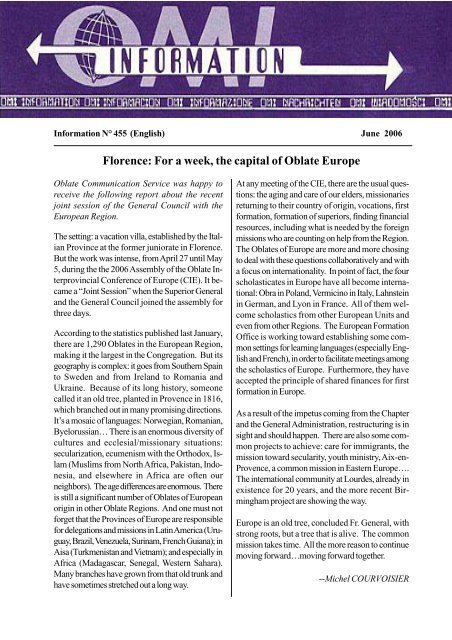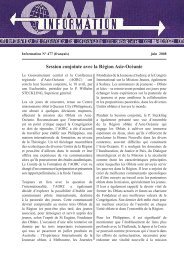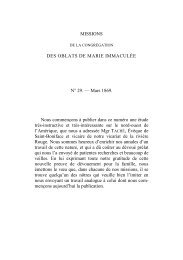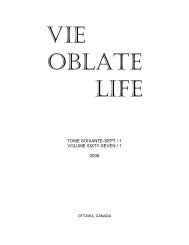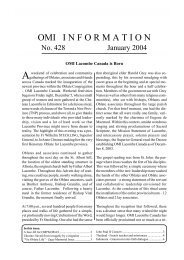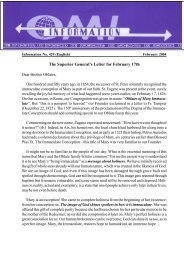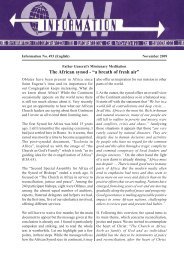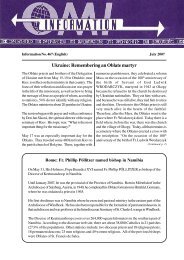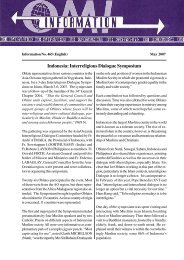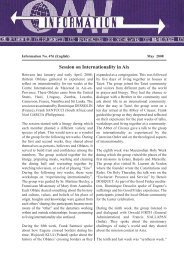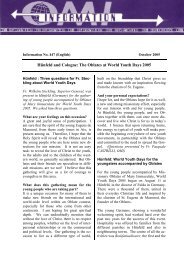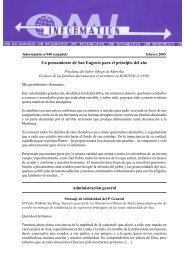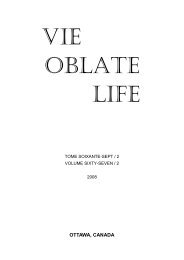Download - Missionary Oblates of Mary Immaculate Communications
Download - Missionary Oblates of Mary Immaculate Communications
Download - Missionary Oblates of Mary Immaculate Communications
Create successful ePaper yourself
Turn your PDF publications into a flip-book with our unique Google optimized e-Paper software.
455/2 June 2006We decided to go a step further by posing somequestions to Jean-Pierre CALOZ, who was one<strong>of</strong> the translators for the session.Who was there?The meeting in Florence was an <strong>of</strong>ficial meetingwhich the provincials, the delegation superiors andsuperiors <strong>of</strong> missions <strong>of</strong> the Region <strong>of</strong> Europe, andonly those, are required to attend. Therefore,present were the provinicals <strong>of</strong> France, Italy, Spain,Germany, Belgium and the Netherlands, the Anglo-Irish Province, and Poland. There were the delegationsuperiors from Ukraine, Scandinavia,France-Benelux (for Polish immigrants), and Austria-CzechRepublic, as well as the superiors <strong>of</strong> themissions <strong>of</strong> Byelorussia and Romania.And why this sort <strong>of</strong> meeting?Nino, can you imagine such a meeting not takingplace? What a shame that would be! Europe isbecoming one, little by little. The uninhibited movement<strong>of</strong> people is making things really open, especiallybetween the East and the West, somethingthat was unimaginable just 20 years ago! But havementalities, cultures and languages made the necessaryadjustments? As <strong>Oblates</strong>, we have the opportunityto be present in most <strong>of</strong> these countries,in the East where we are developing, and in theWest where we are diminishing. It’s therefore urgentthat we work together.What were the subjects discussed?According to the Statutes, the conference managesthe work <strong>of</strong> the Region. Therefore, there are nominationsto make, finances to oversee, directions togive to the various committees: Youth and Vocations,Mission, Treasurers, Formation. These arethe regional “housekeeping” topics. But the conferencealso tries to reflect upon and understandbetter the total reality <strong>of</strong> the Region. This year, thatpiece was provided by the General Council whichreported its view <strong>of</strong> the Region after its visits to thedifferent Units.conduit that communicates but retains nothing. Butlike Pascal’s “thinking reed,” it’s possible to be a“thinking conduit” and to have some ideas.—The crucial issue for the Region is the reorganization<strong>of</strong> its administrative structures. Several Provinceshave fewer and fewer human resources tomaintain a level <strong>of</strong> autonomy; they are, therefore,going to have to revamp the structure <strong>of</strong> the Units.—Given the limited number <strong>of</strong> vocations in WesternEurope, it is necessary to bring together the formationhouses….a single scholasticate for theWest….but where? when? and in what language?—As a Region, Europe feels that it does not have adecision-making center and therefore, it is askingthe General Council to give directions and even takeinitiatives to help in the restructuring.—Move toward more international communities thatare pastorally creative in order to respond to secularityand to immigration issues… moving thereforetoward unstable populations that are also the shapers<strong>of</strong> tomorrow’s world. The <strong>Oblates</strong> have not beenwaiting to begin; many things are happening already.They need to consolidate and channel toward thesenerve centers the new energy coming from elsewherein the Congregation.—It’s the decisive moment. The Units that are willingto open themselves to the demands, the challenges– that’s the word repeated again and again –the risks, the daring, the international….these willlive on and develop while the others will disappear!This is especially the case for Western Europe.Thank God, in the East, it’s a question <strong>of</strong> accompanyingthe growth, <strong>of</strong> being generously daring, <strong>of</strong>avoiding the allure <strong>of</strong> power, but also <strong>of</strong> discerningthe changes. The vitality <strong>of</strong> the East and the experience<strong>of</strong> the West are made to enrich one anothermutually.--Interview by Nino BUCCAWhat were your impressions as translator?The ideal translator is one who serves as a simple
June 2006 455/3Latin AmericaGUATEMALAYouth living and experiencing Oblate missionGreetings from the land <strong>of</strong> the Quetzal. Last December6-8, we had our vocation retreat that takesplace every year at the end <strong>of</strong> the Mission Experience.The retreat was led by Brothers Héctor COC,Rolando ALFARO, Edgar JEREZ, Isidro SALVA-DOR, Fathers Gerardo LE STRAT, ErasmoVÁSQUEZ, Sergio ÁVILA, Oblate Associates,catechists and youth from the community <strong>of</strong> El Pinalin the parish <strong>of</strong> Chicamán.Thirty-two young candidates from different parts <strong>of</strong>the country came with a team <strong>of</strong> <strong>Oblates</strong> for a monthlongexperience <strong>of</strong> living the Oblate mission in Guatemala,especially in the warm area <strong>of</strong> Playa Grande,Ixcán, and the rainy and muddy locale <strong>of</strong> Chicamán,both <strong>of</strong> them parishes in Quiche. For this experience<strong>of</strong> mission, they were divided into four groups,accompanied by an Oblate. They went into differentvillages, sharing with the people, visiting homes, andespecially opening themselves to the reality <strong>of</strong> ourMayan people.One <strong>of</strong> them commented: “By the third day <strong>of</strong> themission, I wanted to go back since a lot <strong>of</strong> rain andmud had destroyed my shoes, but upon seeing thereality <strong>of</strong> the people, their simplicity, their poverty, Irecovered my enthusiasm, bought some rubberboots, and put them on. And so I survived the wholemission. I felt like one <strong>of</strong> them since they all userubber boots; now I know how the Lord is callingme.” During the retreat, everyone could share hismission experience, his difficulties and his joys; therewas also time for reflection, meditation and fun.For the Oblate vocation team, it was a challengesince, for the first time, the retreat took place in acommunity and not in an Oblate house as was thecustom. The results were positive. Spending thenight in different homes, the young men could sharewith the people and know their reality. Furthermore,many youth from the community itself felt the attractionand decided to consider their vocation. Theretreat ended with the perpetual vows <strong>of</strong> our brother,Cruz Agustín CANO, in the town <strong>of</strong> Las Pacayas,Uspantán; Fr. Gilberto PIÑÓN presided at theMass.The youth who decided to begin the formation processwith the <strong>Oblates</strong> came together at the differentformation houses in mid-January to begin the schoolyear. (OMINFORMA enero-febrero 2006)ARGENTINA-CHILEHuman Development ProjectFr. Luis SABARRE, along with his collaborators,Norma Lucero and Paula Correa, from theShrine <strong>of</strong> Our Lady <strong>of</strong> Carrodilla in Mendoza,Argentina, tell us about a very important projectfor the training <strong>of</strong> the faithful <strong>of</strong> the parish.The projects described in this report have been conceivedand developed exclusively to help give newvalue to the manual labor <strong>of</strong> the people <strong>of</strong> our community.For several years now, work, consideredas a source <strong>of</strong> income for the economic sustenance<strong>of</strong> families, has ceased to be seen as a right. Consequently,many needy people with limited resourcesfeel left out by the system. For that reason, throughtheir own generous contribution, specialists belongingto the Caritas organization are working hard toestablish various training opportunities in order togive to the disadvantaged a place in society wherethey can grow through their daily work and be ableto help their families get the bare necessities <strong>of</strong> life.This project has been designed to <strong>of</strong>fer help to everyonewho approaches our community. Therefore,we hope to continue what we began five years ago,but the present economic situation makes it very difficultfor us to carry through with the plan.Light footwear: They work for four hours once aweek under the supervision <strong>of</strong> people who have hadprevious training in shops belonging to the diocesanCaritas <strong>of</strong>fice. They produce thongs, slippers andsandals.Weaving: They are taught to weave by hand and by
455/4 June 2006machine and to crochet. The idea is to get an industrialweaver to make the work easier and to give thepossibility <strong>of</strong> marketing the products, either by individualsor through trade fairs and sales in the community.Embroidery and Painting on Cloth, Wood andGlass: For the development <strong>of</strong> this training project,they use different types <strong>of</strong> cloth, ribbons, needles,woods, glass and different types <strong>of</strong> paint and brushes.Food Project: For ten years now, we have beengiving a box <strong>of</strong> milk and other goods to needy families,but beginning this year, the principal goal is toteach the families and make them aware <strong>of</strong> the benefit<strong>of</strong> milk, not only for the children but for the wholefamily. The plan is to teach them to prepare substantialand nutritious meals as part <strong>of</strong> their ordinarydiet. This work will take place under the strict supervision<strong>of</strong> a health-care pr<strong>of</strong>essional such as a nutritionist.Some years back, we used to give lunch three timesa week to 60 children, but because <strong>of</strong> insufficientphysical space and because <strong>of</strong> some construction inour community, which is still unfinished because <strong>of</strong> alack <strong>of</strong> funds, we had to suspend that project. Ourgoal is to continue this project in a short time, eventhough every month we are helping 30 families and50 children with milk and other goods.MEXICO<strong>Missionary</strong> Holy Week 2006A young Oblate, Roberto TOLENTINO, a Mexicanscholastic, writes about the <strong>Missionary</strong> HolyWeek that he and his companions experienced invarious places in Mexico.Allow me to share with you some details about ourHoly Week mission. Fathers Ariel and FranciscoMARTÍNEZ were the organizers <strong>of</strong> the mission asthey set out from Mexico City, along with members<strong>of</strong> the scholasticate community.The theme to be shared in the villages was that <strong>of</strong>The Family, quite a plateful to <strong>of</strong>fer these good people.The locations where we served in mission thisyear were Huamelula, Quiechapa, Cuajinicuilapa,and San Mateo de Mar (Oblate parishes). Furthermore,we were able to share our missionarypresence in other places such as Vera Cruz andQuerétaro.About a hundred youth, not only from Colegio VistaHermosa, but also enthusiastic teenagers from variousother places in the country joined us in sharingour life with the simple folk who also evangelizedus. Scholastics were sent into each <strong>of</strong> the places toexperience the fervor <strong>of</strong> a lively faith.As for myself, I was able to go to Querétaro withFr. Paco Martínez, where we worked in a communitycalled “Ex-hacienda el Castillo”, a beautifulplace, but generally uncared for pastorally. Therewe noticed the interest <strong>of</strong> the people who filled thechurch and took part in the presentations, the Eastercelebrations for the youth, the rosary at dawn, andother events with which the Spirit inspired us. Themarriage and catechist groups were in fact a greatsupport in our mission.These poor and simple people renewed our ownmissionary zeal. We shared our lives and we helpedthem to live the values <strong>of</strong> the Kingdom that are alreadywithin them. “Lord, bless all families,Amen. Lord, bless mine too!” – that was the songthe people joyfully sang as they shared the themewe suggested.Africa-MadagascarSENEGALThe World Youth Day Cross arrives inSenegal“It was an exceptional event that involved the wholeChristian community,” said Oblate Fr. GiuseppeGIORDANO, the Director <strong>of</strong> the Pontifical <strong>Missionary</strong>Works in Senegal, as he described the arrivalin Dakar <strong>of</strong> the Youth Cross, which began itsAfrican pilgrimage during Holy Week. “The crossarrived at the parish near Dakar’s airport on HolyTuesday. On Good Friday, it was brought to Saint
June 2006 455/5Paul’s, accompanied by a large procession,” saidFr. Giordano. “The visit <strong>of</strong> the Youth Cross inSenegal has re-energized the faith <strong>of</strong> Catholics, whoare in the minority in contrast to the biggest part <strong>of</strong>the population which is Muslim,” stated the PMWDirector, who added: “We have to be careful to explainthe real meaning <strong>of</strong> the Cross in order to avoidany semblance <strong>of</strong> superstition.”“The arrival <strong>of</strong> the Cross during Holy Week, thetime <strong>of</strong> greatest devotion for Senegalese Catholics,gave a real boost to our community,” continued Fr.Giordano. “Generally here in Dakar, the parisheswork hard to welcome the faithful who come forconfession and the Easter ceremonies. Even someMuslim faithful follow the religious ceremonies <strong>of</strong>Holy Week, as a sign <strong>of</strong> esteem for their Christianbrethren.”After leaving the capital, Dakar, the Youth Crossarrived in other areas <strong>of</strong> Senegal. During one <strong>of</strong> itsjourneys, there was a slight accident. “The Crosswas coming back to Dakar from Saint Louis, in thenorthern part <strong>of</strong> Senegal. The small truck that wasbringing it overturned when the driver lost control inan effort to avoid an animal on the road. The truckrolled over. Luckily any injuries were slight, but theCross was broken. Fortunately, a very talented artistwas able to repair it perfectly,” said Fr. Giordano.“You can’t even notice the repairs,” said Fr. ToninoMAZZEO, whose mission at Koumpountum receivedthe Cross immediately after the accident.“Differently from Dakar, my mission is in a regionwhere the Catholics are very much in the minority.The arrival <strong>of</strong> the Cross was an exceptional opportunityto reawaken a sense <strong>of</strong> belonging and the faith<strong>of</strong> our Catholics. The local Muslims also approachedit with respect, thanks to an appeal fromthe local sub-prefect on the radio, a Muslim whoreminded them that in the Islamic religion too, Jesusis respected as a prophet.”After Senegal, the Youth Cross will visit these otherAfrican countries: Guinea Bissau, Gambia, Ghana,Togo, Burkina Faso, Niger, Cameroon, Gabon,Congo Brazzaville, Burundi, Rwanda, Kenya, Malawi,Zambia, Madagascar, Botswana, Swaziland,and South Africa. (Fides Agency 27/4/2006)NATALSt. Joseph’s Theological Institute awards itsfirst degreesThe Catholic Church in Southern Africa passed amajor milestone on Monday 10th April with the celebration<strong>of</strong> the first graduation ceremony <strong>of</strong> degreesawarded by St. Joseph’s Theological Institute (SJTI)as an accredited tertiary education institution. For anumber <strong>of</strong> years our students have had the possibility<strong>of</strong> studying for degrees awarded through the PontificalUrban University in Rome or through the association<strong>of</strong> SJTI with the University <strong>of</strong> KwaZuluNatal. That SJTI now awards its own degrees is asignificant step towards the development in theCatholic Church in South Africa <strong>of</strong> its own “intellectualproperty”, to quote Fr. Stuart BATE, Provincial<strong>of</strong> the Natal Province.At the graduation ceremony 16 students graduatedwith the Bachelor <strong>of</strong> Theology. This is a four-yearpr<strong>of</strong>essional degree which qualifies students for ordination.Eight students graduated with the Bachelor<strong>of</strong> Arts in Religious Studies. This degree is intendedfor persons working in Catholic educationor related fields. Several <strong>of</strong> those who graduated inReligious Studies are sisters who began their degreesseveral years ago as students <strong>of</strong> what wasknown as the Catholic Studies program. Thirtyeightstudents received the diploma in Philosophy.Eight <strong>of</strong> these are doing a third year, hoping to receivethe Bachelors Degree in Philosophy.As Fr. Stuart pointed out in his homily at the Massthat morning, what this is all about is knowledge,truth, which is not something to be taken for granted.It is <strong>of</strong> the Spirit; it comes from above and is precious,and it is not the same as opinion.The guest speaker at the graduation in the afternoonwas Pr<strong>of</strong>. Ron Nicholson, Pr<strong>of</strong>essor Emeritus <strong>of</strong> Theologyat the University <strong>of</strong> KwaZulu Natal. He wasequally eloquent around a similar theme. He quotedGK Chesterton’s biography <strong>of</strong> Thomas Aquinas,which alleges that St. Thomas at the end <strong>of</strong> his lifelooked back at all he had written and found it inadequatein comparison with the majesty and incomprehensibility<strong>of</strong> the divine. He then closed his books,and never wrote again. Most <strong>of</strong> us do not have that
455/6 June 2006privilege. We inevitably use the word to communicatethe Word. We base ourselves on our prayerand on what we learn from the liturgy. But we alsohave to read. We admire and respect the faith <strong>of</strong>many <strong>of</strong> our parishioners, who <strong>of</strong>ten comprehendthings we do not. We are nevertheless practitioners<strong>of</strong> the word, which we are compelled to study if weare to talk about the Word. (Reported by PeterGALLOWAY in the Northern Province Newsletter,April 2006)Canada-United StatesUNITED STATES/ASSUMPTIONAwakening Enthusiasm for VocationsEighteen <strong>Oblates</strong> from the provinces <strong>of</strong> Assumptionand the United States took part in the 13 th VocationalConference at Ferdinand, Indiana, in the U.S.,April 4-9, 2006.The conference, organized by the Benedictine Sisters<strong>of</strong> Ferdinand, had as its theme, “Awakening: ARebirth <strong>of</strong> Enthusiasm in Vocations.” Its purpose wasto help religious communities strengthen and revitalizetheir vocation program and their efforts to gainnew members. Representatives from 28 religiouscommunities who live and work in 9 countries and20 states came to hear practical ideas and a message<strong>of</strong> hope for religious life in the future.The Benedictine Sisters have been organizing thisconference for 13 years in order to share their experiencesand successes in vocation ministry. Theirown community has experienced plentiful vocationsfor many years. There are currently 195 religiousSisters at the convent. Since the foundation <strong>of</strong> theconvent in 1867, over 1,000 women have desiredto live according to the rule <strong>of</strong> St. Benedict.During the six-day conference, the Sisters spoke notonly about the spiritual life but pointed to a contemporarymodel <strong>of</strong> the Church community which mustbe united in a common prayer life, while making wiseuse <strong>of</strong> modern technology and pr<strong>of</strong>essionalism inseeking new members.Some <strong>of</strong> the conference topics were the following:Were Our Hearts Not Burning?Why Not Be Turned Into Fire?Advancing the Mission TogetherTelling the Story! <strong>Communications</strong>Nurturing and Relating in Vocation Ministry!Translating the Dream into Your Reality!NOTRE-DAME-DU-CAPChaplaincy at St. Paul UniversityDaniel RENAUD states that “For an Oblateworking in youth ministry, the university is aplace <strong>of</strong> numerous choices.”I have been the chaplain at St. Paul University inOttawa for nearly two years and this ministry hasproven to be very enriching for me personally. Aschaplain, I am responsible for coordinating liturgiesand prayer events, as well as organizing social andpastoral activities, in collaboration with the StudentAssociation <strong>of</strong> the University.I work in a context that is not only Catholic, ecumenicaland inter-religious, but it also takes place inboth French and English. Besides being a memberon different committees, I <strong>of</strong>fer services <strong>of</strong> spiritualand psychological guidance for the whole universitycommunity.Actually, a good deal <strong>of</strong> my ministry is shared with ateam <strong>of</strong> four students, men and women. Three <strong>of</strong>them are in the first cycle <strong>of</strong> theology and the fourthis in the second cycle, in the Conflict Resolution program.These students have been hired through thework-study program <strong>of</strong> the Ontario government. Farfrom working alone and isolated, I carry on my ministryas chaplain in partnership with many othergroups: the French and English sectors <strong>of</strong> YouthMinistry in the Archdiocese <strong>of</strong> Ottawa, the Sisters<strong>of</strong> Saint <strong>Mary</strong> <strong>of</strong> Namur, “101 Parent,” a Christiancommunity at Sacred Heart Parish in Ottawa, andfinally, the Development and Peace group.The construction and opening <strong>of</strong> a new student residenceon the campus <strong>of</strong> St. Paul University seemsto me to be an important step for our pastoral service.Actually, the presence <strong>of</strong> men and women studentson the campus encourages a lively community
June 2006 455/7life. All that remains is to create a sense <strong>of</strong> belonging;that is the biggest challenge for our pastoral team.A group <strong>of</strong> various ages, an assortment <strong>of</strong> religiousdenominations, and finally the great diversity <strong>of</strong> culturespresent on our campus make for great creativepossibilities.Among activities that bring the university communitytogether, I look after these: the solemn openingMass presided by Archbishop Marcel Gervais, themonthly chaplain’s c<strong>of</strong>fee bar, and the annual weekend<strong>of</strong> Taizé-style prayer.For an Oblate working in youth ministry, the universityis a place <strong>of</strong> numerous choices. Together withteaching in the theology faculty, the role <strong>of</strong> chaplainhas allowed me to forge links with other involvedpersons so as to <strong>of</strong>fer a new formation program forthose interested in youth ministry. I <strong>of</strong>fer this programas workshops and conferences with a team <strong>of</strong>competent and enthusiastic laity. We have already<strong>of</strong>fered some workshops to pastoral ministers in theschools <strong>of</strong> Ottawa and Timmins as well two conferences,one during a day <strong>of</strong> formation <strong>of</strong>fered by theArchdiocese <strong>of</strong> Quebec and the other by the CanadianConference <strong>of</strong> youth ministers in Hamilton.UNITED STATESAn example <strong>of</strong> forgivenessIn the early morning hours <strong>of</strong> September 21, 2005,an arsonist started a fire in the altar server’s sacristy<strong>of</strong> St. Peter’s Church in Sisseton, South Dakota.The fire travelled along a wall to the sacristy on theopposite side <strong>of</strong> the church. The church sufferedmajor damage before the fire was brought undercontrol. In early 2006, the parish learned that theywould be able to repair the present structure withouthaving to build a completely new church.A 17 year old youth confessed that he first brokeinto the Boys’ and Girls’ Club and stole candy. Heleft a trail <strong>of</strong> candy wrappers. Then he broke intoSt. Peter’s where he not only started a fire but managedto dislodge the tabernacle from its base andthrow it to the floor; he also overturned flower vasesand the Paschal Candle.The <strong>Oblates</strong> have served several parishes in theSisseton area for many years. The current <strong>Oblates</strong>there are the pastor, Fr. Norman VOLK, and hisassociate, Fr. Walter BUTOR.The people <strong>of</strong> St. Peter’s are now experiencing thechallenge <strong>of</strong> Jesus to forgive those who hurt us.Thomas Bates, a parishioner, is a candidate for ordinationto the deaconate. His wife, Lois, works inthe pastoral care department <strong>of</strong> the Tekakwitha LivingCenter, a nursing home originally founded by the<strong>Oblates</strong>. Tom had jail visitation as part <strong>of</strong> his pastoralexperience training. In a follow-up reflection hewrote: “As I was visiting the prisoners, I met theyoung man who set fire to St. Peter’s Church. WhenI asked him if he would like to talk with Father Norman,the answer was yes.... Losing the building whereyou worship God is a hard thing. For most <strong>of</strong> thepeople, that building was the place where they werebaptized, were married, and had their children baptized.That building was where they came to burytheir parents. ... Forgiving the person who burnedtheir church would not be an easy thing, but whenFather said that he was going to the jail in order t<strong>of</strong>orgive the young man who had burned the church,he was able to lead his parish by example. ... Later,when the young man wrote Father a letter askingforgiveness from the people at St. Peter’s, Fatherput the letter in the parish bulletin....(they) are beginningto forgive him.” (OMIUSA, May 2006)NOTRE-DAME-DU-CAPL’HumaniTerre: new JPIC newsletterThe Justice, Peace, and Integrity <strong>of</strong> Creation Committee<strong>of</strong> Notre-Dame-du-Cap Oblate Province hasrecently published the first edition <strong>of</strong> a newsletterdedicated to two <strong>of</strong> the great challenges <strong>of</strong> our times:humankind and the planet, both <strong>of</strong> which are endangeredby injustice, over-development, and the exclusion<strong>of</strong> the powerless <strong>of</strong> every sort. This newsletter,which they have named L’HumaniTerre, echoesthe Oblate mission to the “most abandoned,” afundamental option for us. It’s a one-page newsletterthat carries, at regular intervals, short news flashesabout happenings, meetings, publications… includinga supplement: one or two documents that can beconsulted according to one’s interests. This newsletteris being sent by e-mail to members <strong>of</strong> the provincewho have an e-address. If others wish to receiveit, they should send an e-mail to BernardMENARD: bmenard@ustpaul.ca.
455/8 June 2006Asia-OceaniaPAKISTANStudy Seminars in the formation housesIn Lahore, the philosophy students have begun gatheringfor a monthly informal exchange on philosophicalquestions. They call it Philosophy Chowk. Forthose not initiated in the Urdu or Punjabi languages,a chowk designates a round-about for city traffic.The philosophy students use this word to describetheir gatherings much as French speaking communitiesspeak <strong>of</strong> “un carrefour” and English-speaking,a “round-table.”At the theology house in Karachi, the scholasticsare still looking for a name for their seminars combiningOblate studies and social analysis. They beganby calling the seminars: “Oblate Integration: Studyand Action.” However, the name is cumbersome inits attempt to capture the various elements <strong>of</strong> thegoal. The seminars will meet about three times eachyear. The first one was launched in April; its subjectwas the Oblate Mission for Christian-Islamic Dialogue.Presentations were <strong>of</strong>fered relating to: 1) recentOblate Chapter documents on Evangelization andInculturation, 2) the Federation <strong>of</strong> Asian Bishops’Conference’s perspectives on dialogue with Islam,and 3) the present Muslim reality in Pakistan and inthe world and its challenge to the mission <strong>of</strong> interfaithdialogue.In a first phase <strong>of</strong> discussion, the participants sharedtheir own experience <strong>of</strong> the Islamic world and theirgenuine feelings on the prospect <strong>of</strong> dialogue withsuch an imposing giant. From the sharing, it wasobvious that Christians in Pakistan have not enteredthe first step <strong>of</strong> dialogue, understandably, because<strong>of</strong> the abuses experienced in a minority-oppressivecontext.In a second meeting Father Vernon DERRICK ledthe search for interpretation and directions for action.He highlighted important values and indicatedsome areas where relevant action may be taken.Future Oblate mission seminars will adopt a methodologythat includes study, analysis, personalawareness, and decisions for action. The conversationswill follow four phases: 1) gathering <strong>of</strong> data(information), 2) sharing <strong>of</strong> personal reactions andfeelings, 3) interpretation: reflections on theologicalmeaning and values, 4) practical applications:decisions and action.PHILIPPINESDouble celebration at Our Lady <strong>of</strong> GraceParishThere was great jubilation and excitement in the faces<strong>of</strong> Our Lady <strong>of</strong> Grace parishioners on February 18as they marked two great events: the public proclamation<strong>of</strong> the new Vision Statement <strong>of</strong> the parish inCaloocan City, and the blessing <strong>of</strong> the St. Eugenede Mazenod Community Center. The celebrationstarted with the Eucharist presided by BishopDeogracias Iniguez, with <strong>Oblates</strong> concelebrating. TheFilipino Oblate Provincial, Fr. Ramon BERNABEhighlighted the significance <strong>of</strong> the twin events in hishomily.After the homily, the chairperson <strong>of</strong> the Parish PastoralCouncil, Mr. Danny Sanchez, led the parishionersin the ritual proclamation <strong>of</strong> the Vision Statement.The forward-looking and daring vision wasratified by the 430-strong Parish General Assemblyjust the night before. The assembly was precededby four months <strong>of</strong> intensive consultation among theparishioners.At the end <strong>of</strong> the Mass, the people went in processionto the front <strong>of</strong> the new building for the blessing.The inspiring statue <strong>of</strong> St. Eugene de Mazenod wasunveiled by Mayor Enrico Echiverri <strong>of</strong> CaloocanCity. He later spoke <strong>of</strong> the new building as a newlandmark in the city.The new building has eight mortuary chapels to servethe needs <strong>of</strong> the community. The chapels have beennamed after deceased <strong>Oblates</strong>—Bishops Ben DEJESUS and Antonino NEPOMUCENO, FathersBenjamin INOCENCIO, Primo HAGAD, EnriqueGONZALES, Edward GORDON, JosephMILFORD, and. William MCGRATH. The buildingalso houses the MAMI <strong>of</strong>fice, 5 medical-dentalclinics, the Kiddie Learning Center, the VocationalTraining School, and conference rooms for the parish.(Taddy CASTILLO, www.omiphil.org)
June 2006 455/9EuropeITALYAnother doctoral thesis on St. EugeneWhile several <strong>Oblates</strong> have written their doctoralthesis on the life and spirituality <strong>of</strong> the OblateFounder, St. Eugene de Mazenod, recently a member<strong>of</strong> a lay organization for youth in Italy has focusedon him for her dissertation. Adriana Rullo <strong>of</strong>the “Costruire” movement in Calabria defended herthesis on March 23 at the University <strong>of</strong> Messina.“S. Eugenio De Mazenod e la fondazione dellaCongregazione dei Missionari oblati di MariaImmacolata” was the topic <strong>of</strong> her research (St. Eugenede Mazenod and the Founding <strong>of</strong> the Congregation<strong>of</strong> the <strong>Missionary</strong> <strong>Oblates</strong> <strong>of</strong> <strong>Mary</strong><strong>Immaculate</strong>).Adriana received her degree in the Science <strong>of</strong> Educationand Formation. In her study <strong>of</strong> the Oblatefounder, she focused first <strong>of</strong> all on his moral andspiritual formation from the time <strong>of</strong> his exile in Italyuntil his Good Friday conversion in 1807. She thengoes on to tell about the founding <strong>of</strong> the <strong>Oblates</strong>and their work with the poor. In the course <strong>of</strong> herstudies, she was able to consult the Oblate PostulatorGeneral, Frank SANTUCCI. Her bibliographyincludes many <strong>of</strong> the well-known experts on St.Eugene.ANGLO-IRISH150 years ago: a chapel built in 16 hoursBishop Eugene DE MAZENOD met many Irishbishops in Rome for the proclamation <strong>of</strong> the <strong>Immaculate</strong>Conception, in 1854. He noted that theyseemed to welcome the idea <strong>of</strong> the <strong>Oblates</strong> settingup a foundation in Ireland. On that basis he sent FrCasimir AUBERT to Dublin in 1855, but it was onlywhen he was joined by Waterford born Fr. RobertCOOKE that things began to move.Fr. Cooke was fortunate to receive outstanding supportfrom the Augustinian Community at St John’sLane. They invited these first <strong>Oblates</strong> to give a onemonthlong mission at St John’s Lane, and it was thesuccess <strong>of</strong> that mission that led Archbishop Cullento agree to an Oblate foundation in Dublin. He suggested“a spiritually deprived area in the direction <strong>of</strong>Kilmainham.”A 25-acre farm, including a farmhouse, adjacent tothe workshops <strong>of</strong> the Great Southern and WesternRailway, was judged suitable and purchased for£2,150. Fr Cooke took possession <strong>of</strong> the propertyon 21 June 1856—150 years ago this year.He celebrated the first Mass in the farmhouse thenext day, but what <strong>of</strong> the following Sunday whencrowds were expected?A young carpenter promised, astonishingly, to havea large wooden chapel built by the following Sunday,provided the men <strong>of</strong> the Railway Works helped. Helpthey did. On Tuesday, the materials were on theground and that evening seven hundred skilledworkmen started work—after their own full day’swork. From six to nine each night they labored t<strong>of</strong>inish it all by ten on Saturday night. In sixteen hoursthey had built a chapel which continued in use as achurch until the present church was ready.There are so many questions: who drew the plans?Who knew how much and what sort <strong>of</strong> timber? Whogot it there in time? How did they recruit that smallarmy <strong>of</strong> 700 each evening and who marshaled thatarmy?One hundred and fifty years later we can only speculateon such questions. What is beyond doubt is theextraordinary bond that developed between the<strong>Oblates</strong> and the Inchicore community.On Sunday June 25th, President <strong>Mary</strong> McAleese,Councillor Catherine Byrne, Lord Mayor <strong>of</strong> Dublin,and the Oblate Superior General, Fr WilhelmSTECKLING will join the local community for aMass to mark the anniversary <strong>of</strong> this first Oblatefoundation in Ireland.
455/10 June 2006FRANCEAix en Provence - « Pause-Midi » celebrates10 yearsOn March 28 and 30, it was party time in the courtyard<strong>of</strong> the <strong>Missionary</strong> <strong>Oblates</strong> <strong>of</strong> Aix for the 10 thanniversary <strong>of</strong> “Pause-Midi” (Noontime Break).We must not forget that in 1815, even before foundingthe <strong>Missionary</strong> <strong>Oblates</strong> <strong>of</strong> <strong>Mary</strong> <strong>Immaculate</strong>,Eugene de Mazenod bought part <strong>of</strong> the formerCarmelite monastery in Aix as a gathering place forthe “Congregation <strong>of</strong> the Youth <strong>of</strong> Aix.” If this YouthAssociation counted more than 300 youngsters, fromevery social class—from the son <strong>of</strong> the imperialprocurator for Aix to the children <strong>of</strong> the street—itwas because he loved them, he respected them, andhe believed in each one <strong>of</strong> them.With the passing <strong>of</strong> the years, other youth apostolatesgathered at the <strong>Oblates</strong>’ house in Aix: ministries inconjunction with the Society <strong>of</strong> St. Vincent de Pauland a night school for young workers.In 1990, the spiritual heirs <strong>of</strong> Eugene de Mazenodreclaimed an area that had been rented to a business.Its location at the end <strong>of</strong> Cours Mirabeaumade it an ideal setting. They decided to establish anew missionary venture with youth. The ApostolicSisters <strong>of</strong> <strong>Mary</strong> <strong>Immaculate</strong> joined the <strong>Oblates</strong> inthis project. After consulting the diocese <strong>of</strong> Aix,they were able to begin planning in 1994. Pause-Midi was born and the work began. In February1996, Pause-Midi <strong>of</strong>ficially began operation.Today, “Pause-Midi… opens its doors andwarmly welcomes us right in the heart <strong>of</strong> Aixen-Provenceon Cours Mirabeau… In this littlecorner surrounded by trees, in this place teemingwith life and with openness to our ideas, each<strong>of</strong> us finds a place far from the hassles <strong>of</strong> thecity…” (Virginie)Pause-Midi is a place for recreation and relaxation.It’s a place for “re-creation,” a place for listeningand for dialogue and for sharing the meaning <strong>of</strong> life.The anniversary celebrations were prepared by theyouth <strong>of</strong> the Association. March 28 was especiallyset aside for the hundreds <strong>of</strong> members and partners<strong>of</strong> the Association. The “Pausemidians” and theirpartners gathered around a buffet style meal andeveryone was invited to leave a personal mark onthe 10 th anniversary tree. The presence <strong>of</strong> the Archbishop<strong>of</strong> Aix, the Vice-Mayor, and the local Councilorfor Youth showed the interest that the Churchand the city <strong>of</strong> Aix have in Pause-Midi.During the two days, some students <strong>of</strong> Tourism,members <strong>of</strong> the Association, guided visitors throughhistory: from the origin <strong>of</strong> the Carmelite monastery inAix, through the daring <strong>of</strong> Eugene de Mazenod, upto the present day Mission. The involvement <strong>of</strong> theyouth showed us that without the investment <strong>of</strong> themselves,Pause-Midi would have no reason to exist.Therefore, I close, leaving the last word to the youth:“Once you have experienced Pause-Midi, youcannot forget that it is part <strong>of</strong> who you are; it’sour warm and beautiful family without which Iwould not be the person I am today.” (Géraldine)“At Pause-Midi, for the past two years, I’ve discoveredChristians who welcome us in the name<strong>of</strong> their faith, respecting us for who we are. Here,I have discovered a welcoming Church, one thatshares and that accompanies us as we are, thatrespects our differences, that puts itself at theservice <strong>of</strong> others by giving us a welcoming placeto meet that doesn’t exist anywhere else. Otherwise,we would be on the street. That heals melittle by little.” (Aurélie)Yves CHALVET, OMIITALY“Looking for you!” A youth mission“At the beginning, I wasn’t very willing to takepart in this mission, maybe because I didn’t believeso much any more, but after these ten days,I have to believe once more. I appreciated theenthusiasm <strong>of</strong> these missionaries and especiallythe turnout <strong>of</strong> the youth <strong>of</strong> Belevedere for themission. Even youth that don’t go to church. All<strong>of</strong> that led me to believe in the Mission and bepart <strong>of</strong> it. I especially like the idea <strong>of</strong> being ableto approach God through our ordinary hobbiessuch as singing and the computer, and in my case,through workshops. I think a mission such as
June 2006 455/11this should never end.” (Filippo)“The joy, the simplicity, the humor, the resolve<strong>of</strong> the missionaries were essential to the success<strong>of</strong> these days. Being able to approach and to bewith others, even with those who are apparentlyso different and unknown, but united in the name<strong>of</strong> one Person…these are things that struck me.It’s something that will be difficult to forget. I’vecome to understand that it is not necessary to doextraordinary things to give witness; it’s enoughto listen to one’s neighbor: the persons we don’tknow; the persons we love; the ones with whomwe would never have spoken. I thank the Lordfor this breath <strong>of</strong> fresh air and for having givento the youth <strong>of</strong> Belvedere the opportunity to meetthe ‘nurses <strong>of</strong> our souls,’ the missionaries.”(Simona)These words give testimony to the way the Lordtouched the hearts <strong>of</strong> the young people <strong>of</strong> BelvedereMarittimo during a Youth Mission conducted bythe <strong>Oblates</strong> in their town in Southern Italy (Province<strong>of</strong> Cosenza) from March 15-27. All four parishesin this town <strong>of</strong> ten thousand were involved. Twelveyouth from the town joined the four pastors and anun to prepare the mission along with the team <strong>of</strong><strong>Oblates</strong> and members <strong>of</strong> the youth movement“Costruire.”At the Mass to commission the missionary team,Bishop Domenico Crusco, <strong>of</strong> the Diocese <strong>of</strong> SanMarco Argentano-Scalea, spoke <strong>of</strong> the need to walkside by side with the young generations to teach themvalues and the faith. He mentioned the confidencethe Servant <strong>of</strong> God, Pope John Paul II, placed inyoung people.One <strong>of</strong> the highlights <strong>of</strong> the mission was the penitentialservice that took place on Friday, March 24.The service was preceded by a penitential processionthat focused on various martyred missionaries.General AdministrationOblate <strong>Communications</strong> ServiceFor the past few months, there has been the gradualdevelopment <strong>of</strong> a new service at the General Housein Rome. At the Plenary Session <strong>of</strong> the CentralGovernment in September 2005, Oblate <strong>Communications</strong>and Media Service and Oblate InformationService were combined to become Oblate<strong>Communications</strong> Service. At the Plenary Session<strong>of</strong> January 2006, Nino BUCCA was named Director<strong>of</strong> the new service. James ALLEN servesas Associate Director.The 2004 General Chapter directed the GeneralAdministration to seek ways to “foster Media Ministrywithin the Congregation.” This merger <strong>of</strong> servicesand future plans for the new service are responsesto that mandate.The main role <strong>of</strong> the former Information Servicewas to gather Oblate news and documentation anddisseminate it throughout the Oblate world. Itseemed clear to those responsible for it that thistask is simply one use <strong>of</strong> media (print, internet) tocommunicate our message. The next logical stepwas to merge the two services.The “Information Office” <strong>of</strong> the new Oblate <strong>Communications</strong>Service continues to act as a “newsservice,” primarily for worldwide <strong>Oblates</strong>, throughthe publication <strong>of</strong> OMI Information and OMI Documentation.It also publishes OMI Communiquéas prepared by the Central Government after eachPlenary Session. Jim Allen serves as Editor <strong>of</strong> thepublications, gathering items from various sources,editing them as needed, and sending them <strong>of</strong>f to betranslated. He then passes the finished products onto the Webmaster <strong>of</strong> omiworld.org, Nino Bucca.Nino continues to develop the Oblate web site asone <strong>of</strong> our most important means <strong>of</strong> communication.Those who go to the site will have noticed theexpanding list <strong>of</strong> resources available to <strong>Oblates</strong> onthis site: current news, past editions <strong>of</strong> publications,and an ever-growing Oblate library that includes suchitems as Oblate History, writings <strong>of</strong> various SuperiorsGeneral, interviews, and stories <strong>of</strong> Oblate heroesand saints. The Oblate Necrology is now com-
455/12 June 2006pletely on-line in a format that allows the browserto search for names and dates <strong>of</strong> our deceasedmembers from the very beginning <strong>of</strong> the Congregation.It is also possible to download the completeOblate Personnel, as updated on a regularbasis by the General Secretariat, according to theinformation provided by the Units.Nino is also responsible for developing some specialprojects in the area <strong>of</strong> communications. He isstudying the possibility <strong>of</strong> producing a DVD in severallanguages on Saint Eugene and the <strong>Oblates</strong>,as well as the development <strong>of</strong> sessions on communicationsand media, especially for <strong>Oblates</strong> in first formation.Another project he is considering is the creation <strong>of</strong> anetwork among <strong>Oblates</strong> working in the field <strong>of</strong> communications.In order to do this, he needs informationabout what is happening in our Oblate Units. Aquestionnaire was sent to all Units <strong>of</strong> the Congregationin May 2005 to gather this data. At this time,there are still some Oblate Units that have not respondedto the survey.Anniversaries for July 200675 Years <strong>of</strong> Religious Pr<strong>of</strong>ession1931.07.04 05068 Fr. Alcide Cossette Lacombe70 Years <strong>of</strong> Religious Pr<strong>of</strong>ession1936.07.21 06370 Fr. Louis-Paul Lachance Grandin70 Years <strong>of</strong> Priesthood1936.07.05 05221 Fr. Jean-Marie Quéffélec France65 Years <strong>of</strong> Religious Pr<strong>of</strong>ession1941.07.01 07807 Bro. Jean Kanzler France65 Years <strong>of</strong> Priesthood1941.07.06 06286 Fr. Arsène Caby France1941.07.06 06253 Fr. Guillaume Mathieu France1941.07.06 06480 Fr. Wiktor Maria Mendrella Poland1941.07.06 06250 Fr. Albert Schneider France60 Years <strong>of</strong> Religious Pr<strong>of</strong>ession1946.07.16 08164 Fr. Paul-Émile Charland Notre-Dame-du-Cap1946.07.16 08161 Fr. Roland Gagnon Haiti1946.07.16 08165 Fr. Aurélien Giguère Notre-Dame-du-Cap1946.07.16 08166 Fr. André Houle United States1946.07.16 08163 Fr. Jean Morin United States1946.07.16 08139 Fr. Laurent Roy Notre-Dame-du-Cap1946.07.16 08167 Fr. Roland Saint Pierre United States1946.07.25 08168 Fr. Ernesto del Blanco Spain1946.07.25 08305 Fr. Germán Fernández Argentina-Chile1946.07.25 08170 Fr. José María Garmón Argentina-Chile1946.07.25 08644 Bro. Vicente Magaña Spain
June 2006 455/1360 Years <strong>of</strong> Priesthood1946.07.06 07400 Fr. Pierre Rigaud Saint Paul’s1946.07.07 07377 Fr. Jean Loiseau Belgium/Netherlands1946.07.14 07513 Fr. Floor de Grauw Belgium/Netherlands1946.07.14 07613 Fr. Jean Maboge Poland1946.07.21 06689 Fr. August Trapp Germany50 Years <strong>of</strong> Religious Pr<strong>of</strong>ession1956.07.25 10254 Fr. Angel Fernández Argentina-Chile1956.07.25 10649 Bro. Juan Ramón Spain1956.07.25 10110 Fr. Santiago Rebordinos Argentina-Chile1956.07.26 10154 Fr. Andre Dubois Notre-Dame-du-Cap1956.07.26 10150 Fr. Fernand Dufour Notre-Dame-du-Cap1956.07.26 10151 Fr. Laval Tremblay Notre-Dame-du-Cap50 Years <strong>of</strong> Priesthood1956.07.01 09158 Fr. Louis-Marie Chrétien Haiti1956.07.01 09155 Fr. Lucien Jolly France1956.07.01 09187 Fr. Francis Plantin France1956.07.01 09212 Fr. Marcel Rouyer France1956.07.08 08890 Fr. Thomas Bilodeau Lacombe1956.07.08 08827 Fr. Normand Harvey Notre-Dame-du-Cap1956.07.08 09151 Fr. Mieczyslaw Kuchcinski Poland1956.07.08 09152 Fr. Piotr Puzynski Poland1956.07.08 08841 Fr. William Woestman United States1956.07.22 09130 Fr. Jerry Talarski Assumption25 Years <strong>of</strong> Priesthood1981.07.11 11941 Fr. Oliver Rich Lacombe1981.07.18 12408 Fr. Réjean Vigneault Notre-Dame-du-Cap1981.07.24 11644 Fr. Juan de la Cruz Martín SpainOMI INFORMATION is an un<strong>of</strong>ficial publication<strong>of</strong> the General Administration <strong>of</strong> the <strong>Missionary</strong> <strong>Oblates</strong> <strong>of</strong> <strong>Mary</strong> <strong>Immaculate</strong>C.P. 9061, 00100 ROMA-AURELIA, ItalyFax: (39) 06 39 37 53 22 E-mail: information@omigen.orghttp://www.omiworld.orgEditing Team: James Allen (Director), Raúl Castro, Antonino BuccaPrinting: Rajapakse Francis RabindraCirculation: Théophile LePage
455/14 June 2006Suffrages for our DeceasedNo. 32-41NAME PROVINCE BIRTH DIED AT DATEFr. Charles Bérubé Notre-Dame-du-Cap 31/10/1917 Richelieu 16/04/2006Fr. Jozef Kerstens Belgium/Netherlands 04/02/1926 Kapellen 16/04/2006Fr. Henri Ladrière Notre-Dame-du-Cap 31/01/1916 Richelieu 24/04/06Fr. François Péron Thailand 17/03/1929 Loei 25/04/2006Bishop Dominic Khumalo Natal 05/02/1918 Durban 27/04/2006Fr. Gerald Fogarty United States 26/05/1933 San Antonio 28/04/2006Fr. Emil Helfrich United States 20/12/1923 Belleville 02/05/2006Bro. Richard Schultz United States 27/04/1927 Tewksbury 04/05/2006Fr. Azael Katiba Lesako Lesotho 02/08/1969 Maseru 07/05/2006Fr. Camille Losson Cameroon 11/02/1915 Ngaoundéré 09/05/2006“We will keep alive the memory <strong>of</strong> our deceased and not fail to pray for them,faithfully <strong>of</strong>fering the suffrages prescribed on their behalf.” (const. 43)


